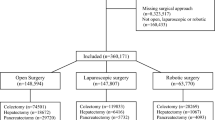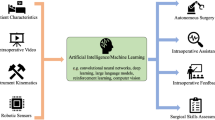Abstract
Background
Minimally invasive surgery in small children and infants requires special skills and training. This experimental study compares the efficiency of an in vitro pelvic trainer (PT) and an a in vivo animal model (AM).
Methods
For this study, 12 residents were prospectively randomized into two groups. Initially, all had to pass a basic skill assessment (3 tasks). Then endoscopic small bowel biopsy was performed (8 times) either with the in vitro PT (group A) or the in vivo AM (group B). Finally, all had to demonstrate this procedure in the in vivo AM and repeat the basic skill assessment. A quality index (complications, suture, biopsy) was evaluated.
Results
Initially, there was no difference between the two groups. Interestingly, the mean regression gradient of the index for the in vitro PT (group A) was significantly better than for the in vivo AM (group B). In the final in vivo operation, however, the mean index for the in vitro PT (group A) worsened significantly, whereas it increased for the in vivo AM (group B) (p = 0.037).
Conclusion
Adequate training for an isolated mechanical task such as gut biopsy can be supplied using a pelvic trainer or animal model with similar effects. However in vivo performance of the same task requires secondary surgical skills, which are conveyed during live training with greater success. Consequently, stepwise teaching with both modules seems reasonable before these procedures are approached in neonates or small children.



Similar content being viewed by others
References
Bohm B, Milsom JW (1994) Animal models as educational tools in laparoscopic colorectal surgery. Surg Endosc 8: 707–713
Cagir B, Rangraj M, Maffuci L, Herz BL (1994) The learning curve for laparoscopic cholecystectomy. J Laparoendosc Surg 4: 419–427
Dent TL, (1991) Training, credentialing and granting of clinical privileges for laparoscopic general surgery. Am J Surg 161: 399–404
Derossis AM, Bothwell J, Sigma HH, Fried GM (1998) The effect of practice on performance in a laproscopic simulator. Surg Endosc 12: 117–1120
Derossis AM, Fried GM, Abrahamowicz M, Sigman HH, Barkun JS, Meakins JL (1998) Development of a model for training and evaluation of laparoscopic skills. Am J Surg 175: 482–487
Edwards CC, Bailey RW (2000) Laparoscopic hernia repair: the learning curve. Surg Laparsc Endosc Percutan Tech 10: 149–153
Hunter JG, Sackier JM, Berci G (1994) Training in laparoscopic cholecystectomy: quantifying the learning curve. Surg Endosc 8: 28–31
Kellnar S, Till H, Böhm R (1997) Thoracoscopic surgery of esophagus in rats: a training concept for treatment of tracheo-esophageal malformations in preterm infants. Pediat Surg Int 12: 116–117
Martin JA, Regehr G, Reznick R, Macrae H, Murnahan J, Hutchison C, Brown N (1997) Objective structured assessment of technical skill (OSATS) for surgical residents. Br J Surg 84: 273–278
Melvin WS, Johnson JA, Ellison EC (1996) Laparoscopic skills enhancement. Am J Surg 172: 377–379
Mori T, Hatano N, Maruyama S, Atomi Y (1998) Significance of “hands-on training” in laparoscopic surgery. Surg Endosc 12: 256–260
Rosser JC, Rosser LE, Savalgi RS (1997) Skill acquisition and assessment for laparoscopis surgery. Arch Surg 132: 200–204
Scott-Conner CEH, Hall TJ, Anglin BL, Muakkassa FF, Poole GV, Thompson AR, Wilton PB (1994) The integration of laparoscopy into a surgical residency and implication for the training enviroment. Surg Endosc 8: 1054–1057
Scott DJ, Bergen PC, Rege RV, Laycock R, Tesfay ST, Valentine RJ, Euhus DM, Jeyarajah DR, Thompson WM, Jones DB (2000) Laparoscopic training on bench models: better and more cost effective than operating room experience? J Am Coll Surg 191: 272–283
Shapiro SJ, Paz-Partlow M, Daykhovsky L, Gordon LA (1996) The use of a modular skills center for maintenance of laparosopic skills. Surg Endosc 10: 816–819
Till H, Kirlum HJ, Böhm R, Joppich I (2001) Thoracoscopic correction of esophageal atresia: training in rabbits provides valuable surgical expertise and shortens the learning curve. Ped Endosurg Innovation Techn 5: 235–239
Wolfe BM, Szabo Z, Moran ME, Chan P, Hunter JG (1993) Training for minimally invasive surgery: need for surgical skills. Surg Endosc 7: 93–95
Author information
Authors and Affiliations
Corresponding author
Rights and permissions
About this article
Cite this article
Heinrich, M., Tillo, N., Kirlum, HJ. et al. Comparison of different training models for laparoscopic surgery in neonates and small infants. Surg Endosc 20, 641–644 (2006). https://doi.org/10.1007/s00464-004-2040-7
Received:
Accepted:
Published:
Issue Date:
DOI: https://doi.org/10.1007/s00464-004-2040-7




